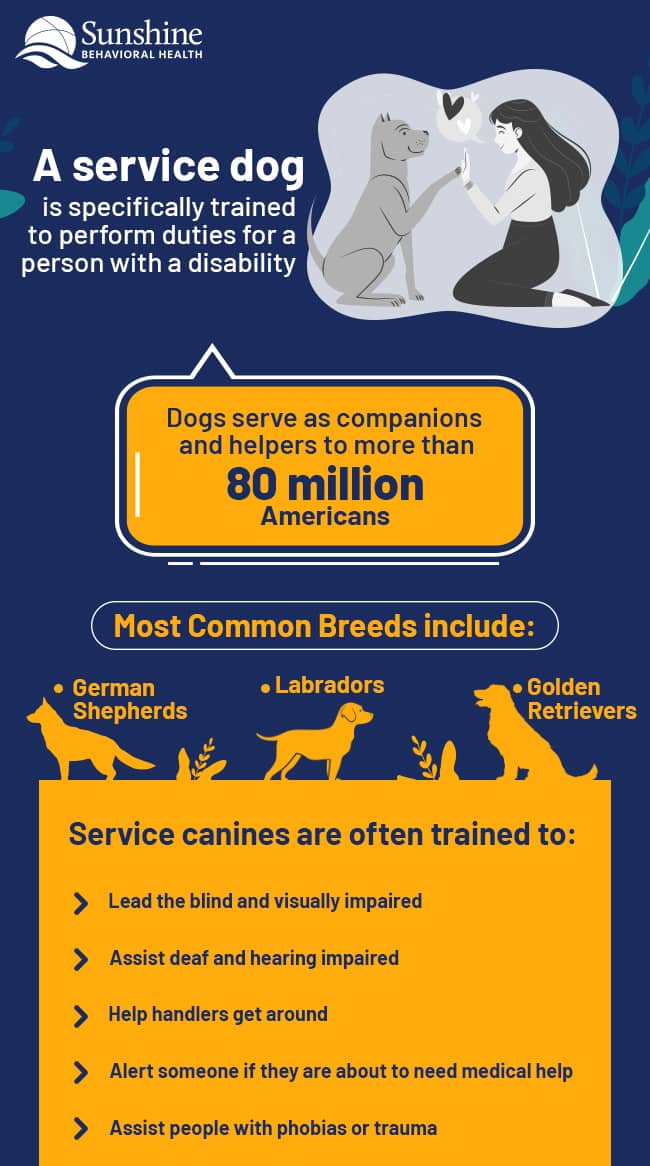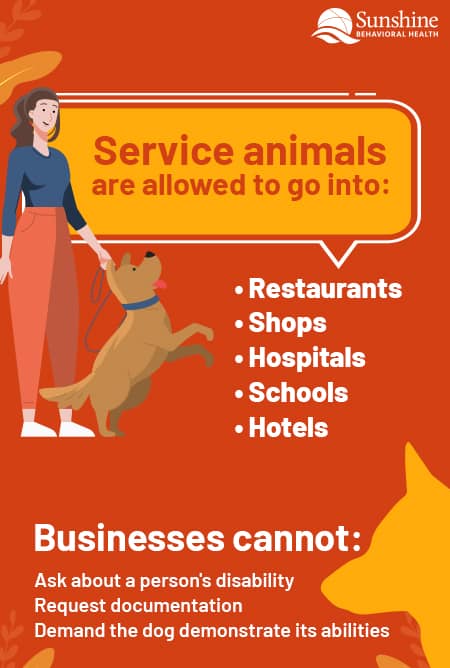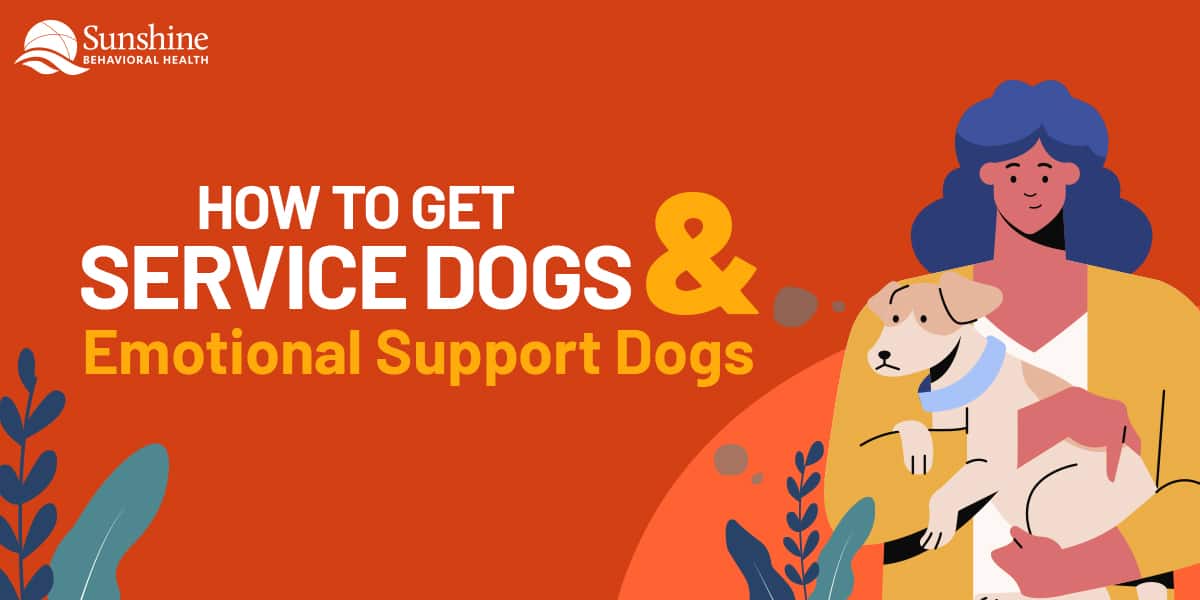Service dogs. Emotional support animals. Therapy animals. All three types of helper animals can do humans a world of good, but they serve different functions.
Service dogs are trained to perform duties for a disabled person that helps them retain greater independence, like helping a blind person get around.
Emotional support animals are not trained for specific duties. Instead, they serve as companions and can help with a person’s anxiety or depression, for example.
Therapy dogs work with a person to volunteer in hospitals, schools, and more, where they provide some comfort and affection to the people they visit.
 What is a Service Dog?
What is a Service Dog?
The Americans with Disabilities Act (ADA) has a broad definition of “disability.”
There is flexibility there, whether it’s a physical, mental, or emotional issue. If a person has a condition or impairment that limits or makes it difficult to do an important life activity, then they could qualify for a service dog.
The ADA does not list all potential impairments, but a diagnosis of blindness, cerebral palsy, diabetes, epilepsy, heart disease, or paralysis — those and many others would pass muster.
Major life activities include self-care (bathing, dressing, going to the restroom) or everyday tasks like eating, seeing, communicating, working, and more. In some cases, service dogs would be trained to alert and protect someone on the verge of having a seizure.
It’s not necessary to have a doctor’s letter to qualify for a service dog, but proof of disability can be helpful if the animal’s need comes into question.
Only dogs are recognized as service animals according to the ADA. They are not pets, though many handlers form powerful bonds with the animal. There usually is a “no petting” policy, because people interacting with the dogs can distract them from their duties. It may be irresistible to try and get the dog’s attention, but it’s better to ask the handler first about petting or interacting with the canine.
These dogs are trained to do specific tasks for the person they’re paired with.
Types of Service Dogs
Service dogs help people with disabilities live more independent lives. Canines can be trained to perform any number of tasks, including:
- Guide dogs: Help the blind and visually impaired get around
- Hearing dogs: Assist the deaf and hearing impaired
- Mobility dogs: Help their handlers get around
- Medical alert dogs: Let a person know if they need or are about to need medical help (if a seizure or blood sugar crash is imminent, for example)
- Psychiatric service dogs: Help people with phobias or trauma
Typically the best service dogs are focused on their handlers, and they are not easily distracted.
Psychiatric Service Dogs
Most people might think of a service dog as doing tasks like helping their blind handler get around, but they can serve in less obvious, but just as vital capacities, by providing psychiatric support.
Like service dogs, psychiatric service dogs are also specifically trained to do certain jobs, must alleviate a person’s disability, and be needed by that particular handler. They would be trained to assist handlers with specific mental conditions, including:
- Anxiety
- Depression
- Bipolar disorder
- Panic attacks
- Obsessive-compulsive disorder (OCD)
- Post-traumatic stress disorder (PTSD)
They may also help people with certain phobias, especially social ones or cases of agoraphobia.
Instead of performing tasks like helping their handler pick up a dropped object or pulling a wheelchair around (to cite two examples), a psychiatric service dog might help his or her person wake up, calm them when they’re anxious, retrieve medication or water when the handler cannot, seek help as needed, or give nudging reminders that it’s time to take medication.
ADA and Service Dogs
Service dogs are covered by the ADA, and are allowed to enter public spaces like restaurants, shops, hospitals, schools, and hotels. They can live with and travel with their owners.
 According to the ADA, when it is not clear what service an animal provides, workers in public areas are only allowed to ask two questions of the handler:
According to the ADA, when it is not clear what service an animal provides, workers in public areas are only allowed to ask two questions of the handler:
- “Is the dog a service animal required because of a disability?”
- “What work or task has the dog been trained to perform?”
They cannot ask about the individual’s disability, request documentation, or demand the dog demonstrate its abilities.
There are state and local laws that may have a broader definition of service animals than the ADA does. Specific information would be available through that state’s attorney general’s office.
What is a Therapy Animal?
Therapy animals often work in healthcare, assisted living, and school settings. They’re mostly dogs, but can include cats, horses, and other animals. A therapy animal might visit a nursing home to cheer up or engage with residents, and the people they visit can derive physical, emotional, and psychological benefits from being able to pet the animals or enjoy a bit of companionship.
They’re trained to work with groups, or a variety of individuals, sometimes by their owners or handlers. They’re usually friendly, calm, and easy-going.
They do not have the same access that service dogs do (like entering businesses with a “no pets” sign).
What is an Emotional Support Animal?
The ADA distinguishes between service dogs and emotional support animals. Service animals are always dogs.
Emotional support animals (ESAs) provide companionship and comfort for individuals with mental illness, and must be prescribed by a licensed mental health professional. ESAs are not afforded the same rights as service animals (which are permitted to travel on airplanes for free, or accompany handlers in stores and restaurants, or to the classroom or workplace). It’ll cost the owner of an ESA to transport them, and they’ll have to be in a carrier or kennelled in the belly of the plane.
ESAs are, however, allowed to live with their owners when they live in areas covered by Fair Housing Amendments Act regulations.
Animal-Assisted Therapy
Animal-assisted therapy (AAT) is when animals help in treatment, usually with a licensed therapist guiding the process. (Animals can also help in education or activities).
As a part of treatment, AAT can help both a person’s mental and physical health.
Mentally, petting an animal promotes relaxation and increases the release of hormones (serotonin, prolactin, and oxytocin) that are linked to better moods. Anxiety goes down, comfort levels rise, loneliness is eased, and if a person is shy or hesitant about therapy, the presence of an animal can help break the ice.
AAT even has been found to be of great help in treating substance use disorders. Establishing bonds, providing support, and setting routines are three ways they can help. Their role in reducing anxiety can prevent relapse. Having a pet in itself, and something to be responsible for, can be a powerful motivator in staying sober.
One study compared substance use disorder treatment groups (dogs vs. no dogs); the findings showed that the presence of the animal resulted in a more positive view of treatment.
Another study examined dual diagnosis patients (who had a mental disorder and a substance use disorder) and found AAT improved motivation, attention, cooperation, and involvement in treatment.
Physically, an animal can help lower one’s blood pressure, and just the presence of an animal can help the release of happy hormones (the same ones linked to chocolate).
Service Dogs for Veterans
Veterans can benefit greatly from service dogs, who provide life-changing and sometimes even life-saving assistance.
It’s not clear exactly how many veterans who have served in conflicts through the decades have PTSD, but it’s estimated that the number may be as high as 30%. On average, 20 veterans take their lives each day. (The added stress of the coronavirus pandemic, as well as events in Afghanistan, haven’t helped, either.)
Calls to veterans crisis lines surged in 2020, but service dogs trained to help those with PTSD resulted in fewer suicidal behaviors and feelings compared to those with emotional support animals.
Sometimes the Department of Veterans Affairs (VA) may cover the cost of getting a service dog. It’ll require doctor approval, a review, and paperwork. If prescribed by the VA, vet care and equipment (but not grooming, boarding, food, etc.) will be covered.
There are programs, like Pups4Patriots, which rescue and train shelter dogs to help veterans with PTSD or traumatic brain injuries. The dogs typically are provided free to veterans who need them. The dogs can help with stress, anxiety, and depression, as they provide comfort and help vets deal with crowds and the public.
To better help meet the need, the Puppies Assisting Wounded Servicemembers (PAWS) was signed in August 2021. It tasks the VA with setting up a program to train and provide service dogs to PTSD-afflicted veterans.
Who Can Have a Service Dog?
It’s not that difficult to qualify for a service dog.
A person would need written documentation from a healthcare provider that states they have a disability or an emotional or psychiatric disorder, and that they need an animal’s help as a result.
Only dogs qualify as service animals, and they must be specially trained, a process that can take years.
Getting a service dog can be more challenging. It’s best to reach out to an organization that specializes in training dogs for specific conditions (seeing-eye dogs, for example). Trainers will understand the client’s needs and work with the client and dog to ensure a good fit. Service organizations screen the dogs, too, so there are no surprises about health or temperament.
It can take time and money to get a dog, however. A lot of organizations have long waiting lists, as long as five years, even. Not every dog who enters a program graduates from it, either. Some have health issues or they aren’t an ideal fit for service.
Also, the price tag to raise and train a dog can amount to thousands of dollars (tens of thousands, even). Some organizations with resources may be able to provide a service dog at a deep discount or even for free (that can mean a longer waitlist, too). Sometimes families, clubs (Eagles, Lions, etc.), and communities hold fundraisers. In some cases, grant monies may be available, too.
People can also train their own service dogs. The American Kennel Club and other organizations have advice on that.
Best Breeds
There is no one best breed of helper dog. One kind of dog will be better to help someone with mobility issues, but another will be better at spotting a seizure on the horizon.
A number of things should be considered when looking for a therapy or helper dog, including:
-
- Temperament. Do you want a calm dog? A sociable one? A lovable one?
- Size. A large or strong dog can help with mobility. A smaller breed may be fine for detecting allergens or an impending seizure.
- Coat. Do you live in a hot climate or one with cold winters? Will you be able to groom a longer-haired dog’s coat?
- Energy. What tasks will the dog need to perform? Will it have enough energy to do them, or will it be sitting around too much?
- Strength. Will the dog be strong enough to help you get up or pull a wheelchair?
- Intelligence. How easy is it to train a particular breed? Will it do complex tasks? Will it be easily distracted?
There are hundreds of dog breeds in existence (and many more, when considering mutts and hybrids like Labradoodles). Breeds are categorized by various traits, like sporting (to help hunters); hounds (to track game or find people); herding (originally bred to corral livestock); working (to pull sleds or guard property); and more. Out of hundreds of breeds, there are some standouts who get chosen and trained to help humans time and again:
- Labrador Retriever: These are a highly coveted breed because they have an easy-going nature, are sociable, loyal, intelligent, and they’re strong, and athletic.
- Golden Retriever. They have many of the same winning qualities as labs, including a calm temperament, brains, and strength.
- German Shepherd. German shepherds were the first guide dogs used, starting in the 1920s. They’re smart, alert, brave, loyal, and capable of handling a wide range of duties.
- Poodle. This may seem like a strange choice but poodles are clever, sociable, and flexible. Their excellent senses of smell can be trained to detect allergens. Larger Standard poodles can help with mobility. They’re also a good choice for people with allergies because they produce less dander.
- Bernese Mountain Dog. These giant canines are bright, easygoing, and loyal. Their size and strength make them great choices for pulling a wheelchair or helping their handler get up. They don’t distract easily, either.
- Great Dane. These huge dogs are not only tall but strong. That can be a big boost to mobility challenges, and they also have a lovable nature, so they can offer comfort for psychiatric issues.
- Collies. These canines can help epileptics since they can be trained to pick up on an impending seizure. They also are calm and cheerful, ideal for people with PTSD and related issues. Their long coat requires added grooming, however, so they may not be ideal for everyone.
- Border Collies. These intelligent dogs are easy to train and thrive on having a job to do. They need lots of stimulation and exercise, however.
- American Staffordshire Terrier. Because of their stocky builds, they can help with mobility, but they’re also suited to a wide variety of tasks because of their intelligence and good nature.
- Pomeranian. These poofy little pooches are tiny but can pack a helpful punch. Their strength lies in alerting owners of problems connected to diabetes, asthma, and more. They can also help people with hearing problems. Their small size makes them more portable, too.
Service and support animals aren’t limited to the above breeds, however. The dog itself and the needs of the individual factor into the equation, too. There are a wealth of animal-centric organizations with advice, resources, and services. Below are a sampling of websites that can be useful in doing research or picking up information.
Resources
Sources
Medical disclaimer:
Sunshine Behavioral Health strives to help people who are facing substance abuse, addiction, mental health disorders, or a combination of these conditions. It does this by providing compassionate care and evidence-based content that addresses health, treatment, and recovery.
Licensed medical professionals review material we publish on our site. The material is not a substitute for qualified medical diagnoses, treatment, or advice. It should not be used to replace the suggestions of your personal physician or other health care professionals.






